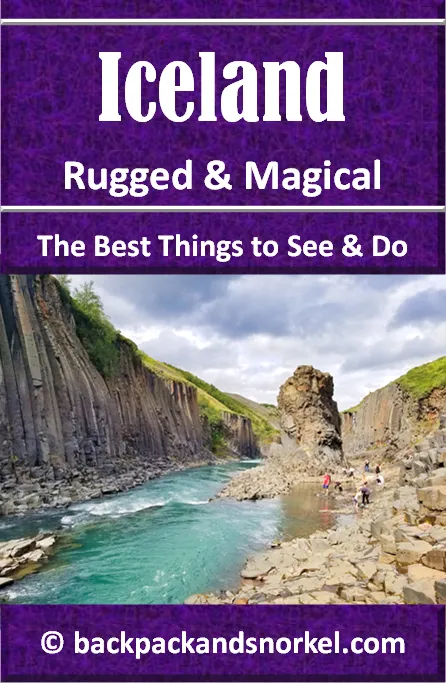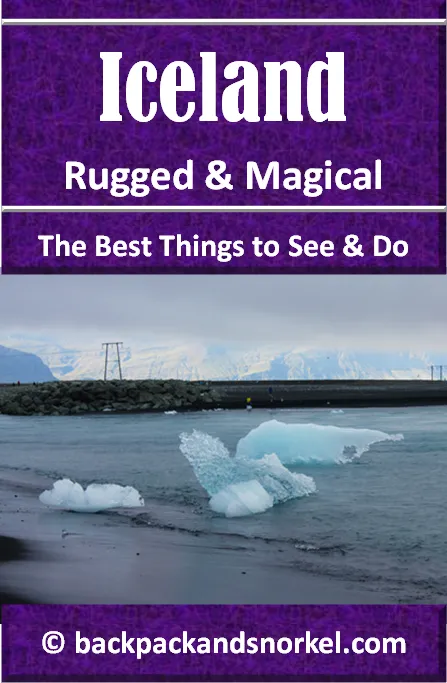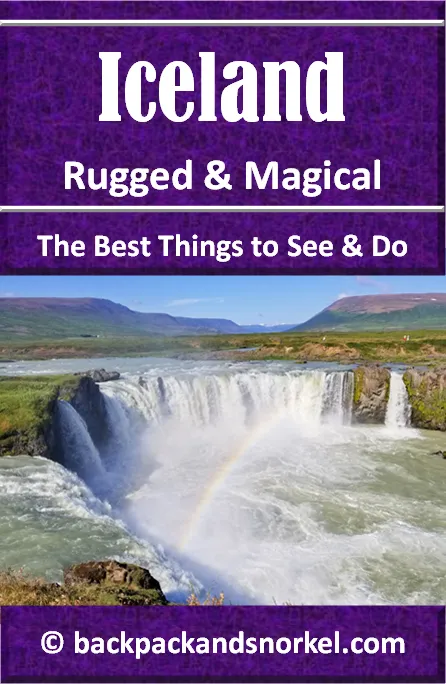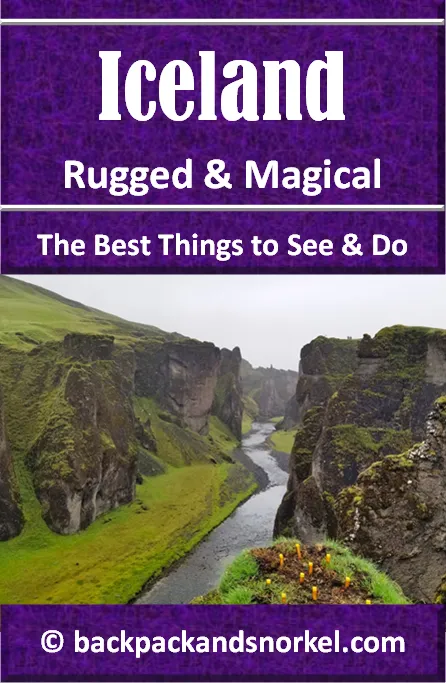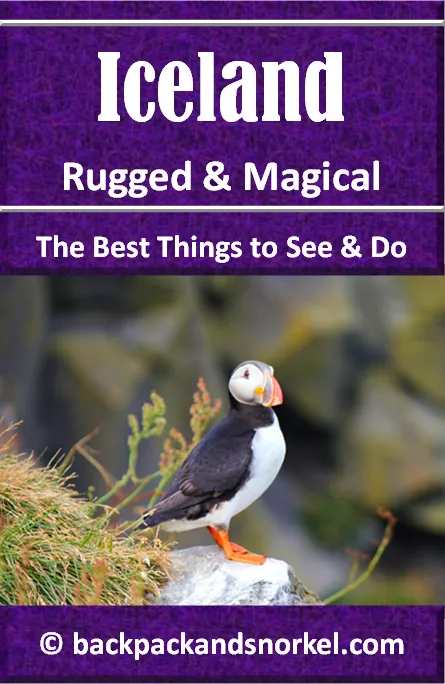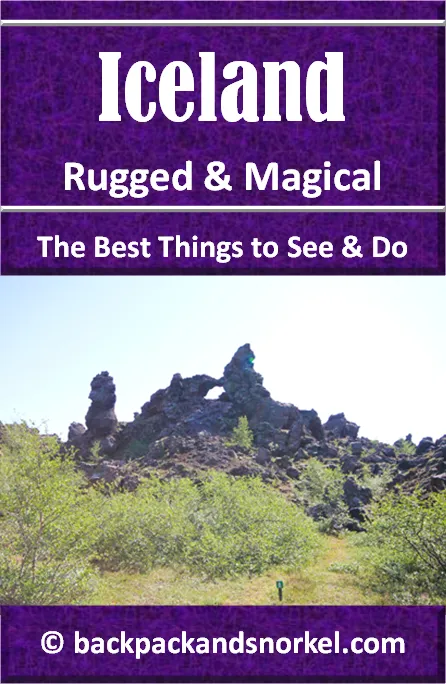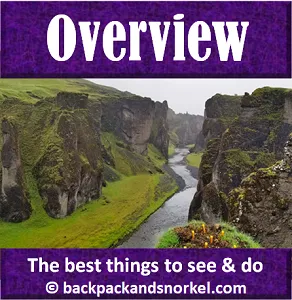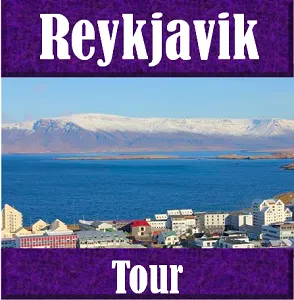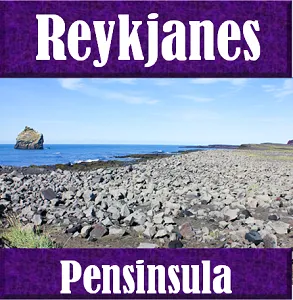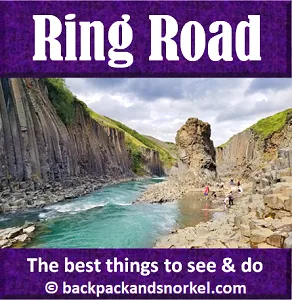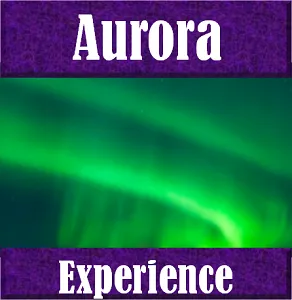Self-Guided Tour of Reykjavik - Reykjavik Purple Travel Guide
Reykjavik is the capital of Iceland. It can easily be toured in one day. We provide you a detailed itinerary with the best things to see and we show lots of photos so you know what you can expect.
Some of the attractions are located in central Reykjavik, but you will need a car for some of the highlights. Alternatively, you can take a bus or a taxi.
Depending if you like to start your day watching birds or taking a bath in a thermal pool, you can do this itinerary as described or do it backwards. We prefer to take the bath at the end of a long adventurous day.
For more detailed information incl. links to google maps locations, more reviews, website links, etc., check out our Iceland Purple Travel Guide.
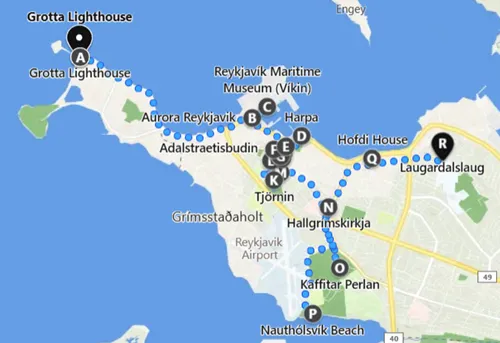
- Grotta Lighthouse
- Aurora Museum
- Reykjavik Maritime Museum
- Harpa Concert Hall
- Bæjarins Beztu Pylsur
- Adalstraeti
- Austurvollur Square with the statue of Jon Sigurdsson
- Althingi Parliament House
- Domkirkjan (City Cathedral)
- Hotel Borg
- Tjörnin
- Reykjavik City Hall (Ráðhús)
- National Gallery of Iceland
- Hallgrímskirkja
- Perlan
- Nauthólsvík Beach
- Höfði House
- Laugardalslaug
Here at Backpack and Snorkel Travel Guides, we typically promote self-guided walking tours.
But we realize that not everybody likes to walk by themselves in a foreign city. So, just in case that you rather go with ab guide: NO PROBLEM! Please see the free GuruWalk and paid Viator tours below.
free GuruWalk tours
paid Viator tours
- Grotta Lighthouse
The Grótta Lighthouse sits on the tied island of Grótta, which belongs to the Reykjavik suburb of Seltjarnarnes.
“Tied Island” means that the only connection to the mainland is completely submerged during high tide and you can only walk to the lighthouse during low tide.
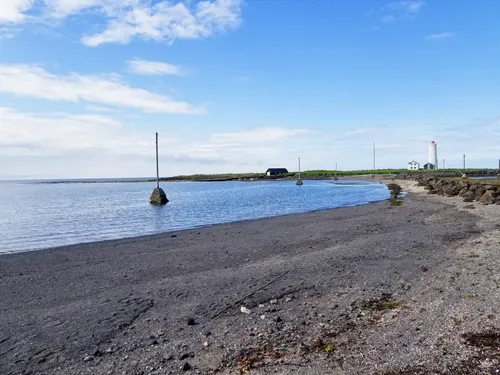
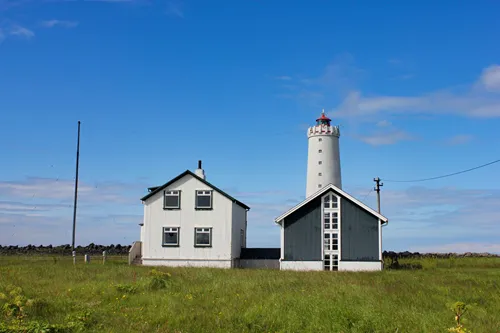
Grótta is a nature reserve since 1974 and it is an important nesting ground for arctic terns. To protect nesting birds, Grotta is off limits to anyone between May 1 to July 31. If you come during that time, observe the birds and lighthouse through your binoculars and take one of the hiking paths to enjoy this peaceful area. But do not attempt to walk to Grotta.
The lighthouse you see today was built in 1947 and it replaces an earlier lighthouse from 1897. It was deserted in 1970 and only after the municipality acquired it in 1994 was it occasionally used for school trips.
Since there is comparably light pollution, the lighthouse is a popular spot in Reykjavik to see the Aurora Borealis.
Seltjarnarnes was founded as a township in 1947 and it is the smallest township by land in Iceland.
- Aurora Museum
The Aurora museum is a very small museum that focuses on the Aurora Borealis. It tells you about the importance of the aurora in the mythology in various countries, it explains how the aurora is formed and what the different colors mean, and it has a small theater where it continuously shows a movie with aurora clips taken in many different locations in Iceland. This movie was a definite highlight for us, and we spent most of our time watching it.
Plan about an hour for this museum.
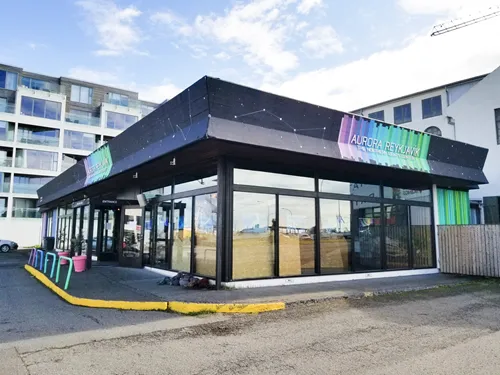
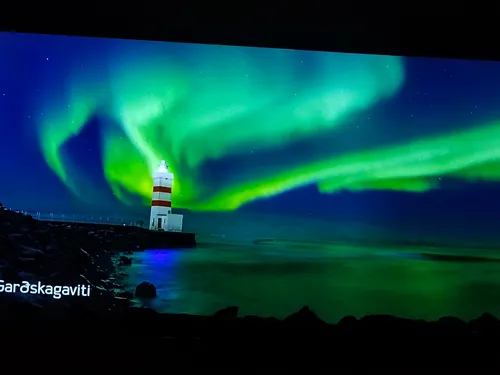

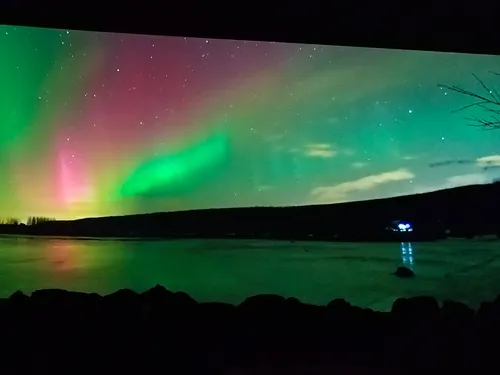
- Reykjavik Maritime Museum
This museum, part of the city museum, is all about Iceland's main export industry: fish and fishing. It was built in 2005 and is located in an old fish-freezing plant.
You will see lots of nautical artifacts, the captain's room, and narrow sleeping quarters.
- Harpa Concert Hall
Harpa opened in 2011 and is Reykjavik's premier music and event venue conference center. With its dramatic honeycomb structure, it is an easily recognizable landmark in Reykjavik. It was built so that it reflects both the sky and the ocean. The state-of-the-art acoustics make the concerts and films a special experience.
I you cannot get enough of the almost daily performances; you can buy tickets for a guided tour.
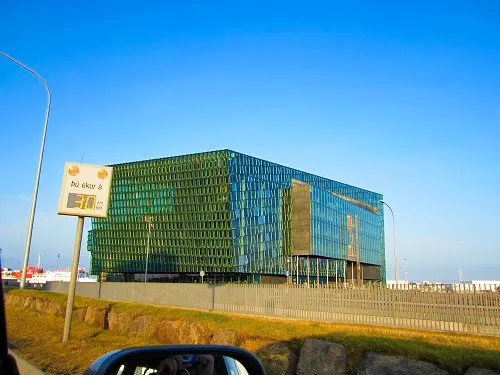
After this relaxing start to your day, drive to downtown and try Iceland's most famous hot dogs at your next stop.
- Bæjarins Beztu Pylsur
Bæjarins Beztu Pylsur literally means "The Town's Best Sausages". Even though part of a chain of 4 restaurants in Reykjavik, this specific hot dog stand, which is selling hot dogs in this location since the 1960s, became famous after US President Bill Clinton visited it in August 2004 while he was visiting Iceland for a UNICEF conference. Other celebrities who have visited this stand are Charlie Sheen, Kim Kardashian, and James Hetfield (Metallica front man). It was also featured by Anthony Bourdain’s “No Reservations” show.
After Bill Clinton's visit, this location became popular and started appearing in travel guidebooks and in August 2006, the British newspaper The Guardian selected it as the best hot dog stand in Europe.
The hot dogs that Bæjarins Beztu sells are lamb-based and also contain pork and beef. They come with a bun of choice and several condiments of choice. If you want to brag with your best Icelandic, then you could say 'eina með öllu', which means 'one with everything'.
Iceland is expensive and this hot dog stand is extra expensive. Expect to pay more than 4 Euros for a small hot dog.
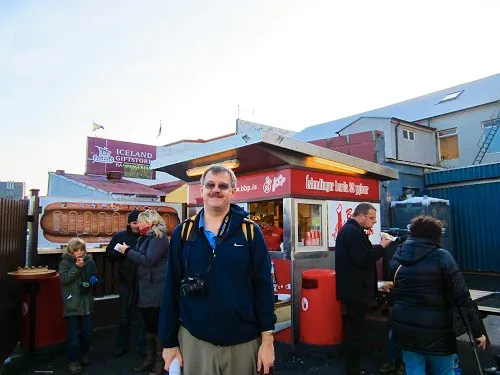
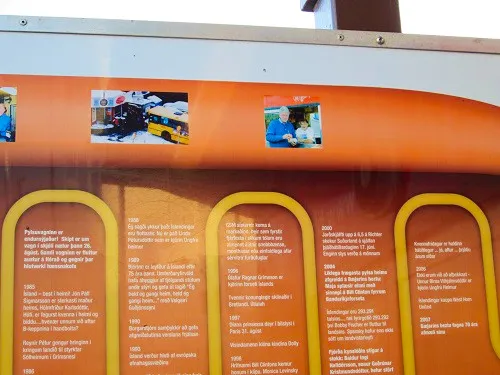
Get back to your car and find a parking spot near Austurvoellur Square and start exploring Reykjavik.
- Adalstraeti
Adalstraeti (Aðalstræti = 'Main Street') is the oldest street in Reykjavík. Back in the 18th century, this street connected the main farm at the southern end of this street to the harbor. The dark brown building with house number 10 was built in 1762, which makes it the oldest still standing building in Reykjavik.
Since 2018, it is part of the Reykjavík City Museum and houses a small exhibition containing old photographs that detail the history and people of Reykjavik.
Opening times are 10am-5pm and admission is 1,650 ISK per person.
Plan 30min for the museum.
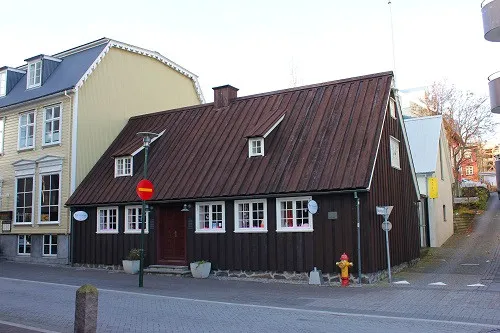
Now walk to Austurvoellur Square with the statue of Jon Sigurdsson.
- Austurvollur Square with the statue of Jon Sigurdsson
The square is lined with landmark buildings which are important to the city’s history, like the Parliament building, Reykjavik‘s cathedral Domkirkjan, and Hotel Borg. You will find many cafes on Vallarstræti and Pósthússtræti. The square is dominated by a statue of Jon Sigurdsson, who was the leader of the Icelandic independence movement in the 19th century. Besides the statue, you will find him on the 500 Icelandic króna bank note, some stamps, and his birthday (June 17) is Iceland's National Holiday.
The plaza is also known for protests against the handling of the financial crisis by the Icelandic government. The protests started on October 11, 2008 were organized by the political organization "Raddir fólksins" (=Voices of the people). They were held every Saturday until the resignation of the government of Prime Minister Geir Haarde in 2009.
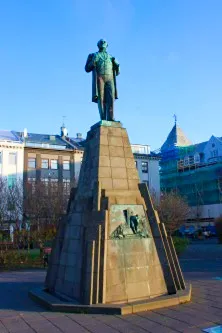
Walk over to Althingi Parliament House.
- Althingi Parliament House
This unassuming small black stone building was built in the 19th century and houses the most ancient parliament in the world, continuing the tradition started at the Law Rock in Thingvellir.
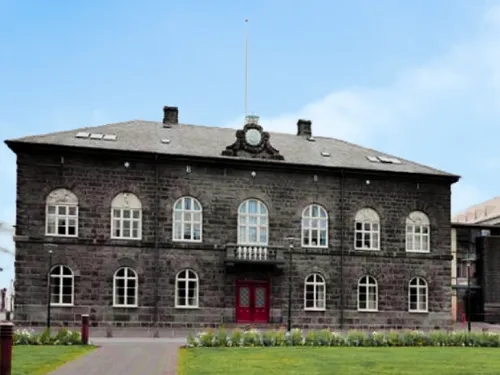
Now walk over to Domkirkjan (City Cathedral).
- Domkirkjan (City Cathedral)
This is the city's oldest church and since 1845, each session of parliament begins with a mass at Domkirkjan.
This small and charming cathedral is the seat of the Bishop of Iceland, the central church of the Evangelical Lutheran Church of Iceland and the parish church of downtown Reykjavik.
This place has been occupied by multiple church buildings since the 13th century. The current church was built from 1787-1796 in traditional Lutheran church building style with simple and clean lines.
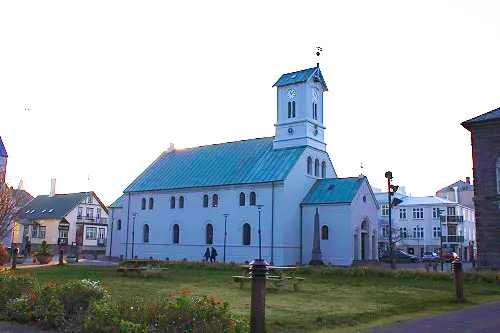
- Hotel Borg
Built in the 1930s, hotel Borg is Iceland's first luxury hotel and a historic landmark known for its signature art deco style. The hotel has 99 rooms which are individually decorated with custom furniture. There is also a spa, hot pool, steam bath, sauna, relaxation area and a gym.
We did not stay in this hotel - if you stayed there, please let us know what you think.
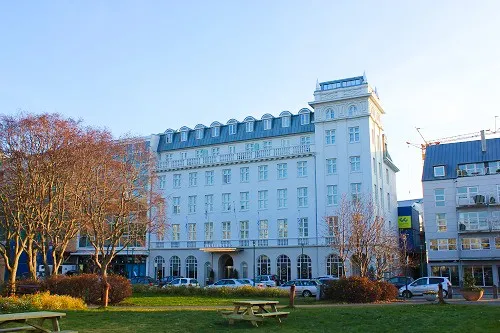
- Tjörnin
Tjörnin, which means 'Lake' or 'Pond', is a prominent lake in downtown Reykjavík. We took a stroll around part of the scenic frozen lake and then, right before we were frozen stiff, got into the warm city hall which is the next stop on our tour.
The lake is said to be frequented by 40-50 water bird species only had a dozen or so ducks and geese sitting and walking on the ice when we were there. We saw some people feeding them. Apparently, bird feeding is so popular here that the pond is sometimes referred to as 'the biggest bread soup in the world'.
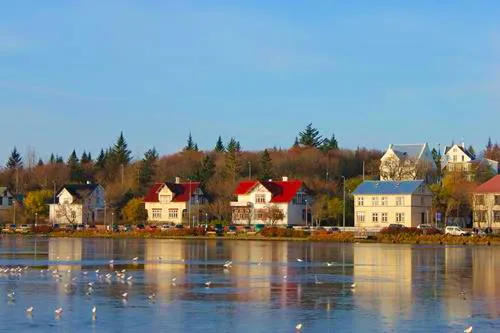
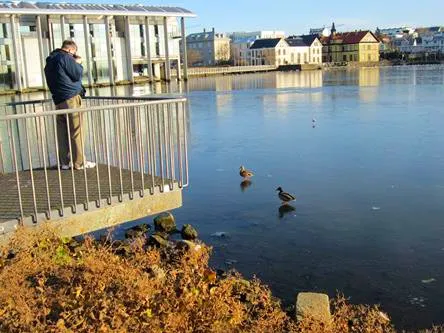
- Reykjavik City Hall
This modern City Hall, which was inaugurated in 1992, is built at the edge of the Tjörnin lake and looks as if it is rising out of it. We went inside and as we were there on a weekend, the building was nearly deserted, and the upper floors closed.
The ground floor is open every day and serves as a place to relax all year round; there is even a small cafe. There is a typographical model of Iceland and when you look out of the windows, you will have beautiful views of the lake. When we were there, there was kind of a cultural event ongoing, and people brought their kids to play.
Interestingly, the idea to build a city hall is almost as old as Reykjavik itself and dates back to 1799. It then took until 1918 to form the first committee to discuss building a city hall. Money to build city hall was allocated in 1929, but the plans were never implemented. In 1941, a second committee was appointed and in 1945 the Executive City Council agreed to the site proposals. A year later, in 1946, the first design competition was held with three site options, but none won the first prize. In 1950 the City Planning Co-ordination Committee proposed locating city hall on the northern end of the lake, and in 1955 City Council agreed unanimously to a location facing the northern end of the lake. Six architects were invited to submit plans and in 1964 the proposals and design details were put on public display. You may have guessed it by now, none of the construction plans were ever implemented.
Finally, in 1984 mayor David Oddsson took action to build city hall at the Northern end of the lake, he made sure that 2 lots in the northwestern corner of the lake were earmarked in 1985 and in 1986 the second design competition took place. A total of 38 entries were received and in June 1987 and the first prize was awarded. In October 1987 the site and preliminary plans were approved by the City Council and the groundbreaking ceremony was held in April 1988. Three years later, in April 1991 the cornerstone was laid by mayor Davíð Oddsson and in April 1992 city hall was finally inaugurated.
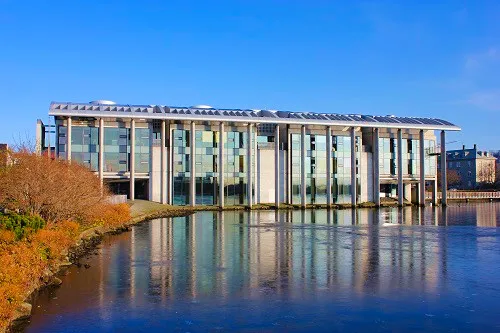
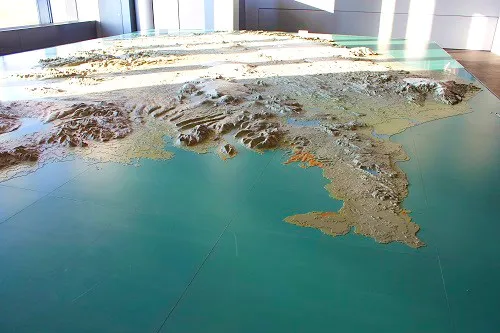
From city hall, walk or drive over to the National Gallery of Iceland.
- National Gallery of Iceland
The National Gallery of Iceland houses a collection of Icelandic art, but it also has rotating exhibitions of foreign artists. When we were there, the museum had modern Icelandic art on display that was too abstract and "modern" for us, and it did not really appeal to us. If you are into abstract modern art, then you may be delighted.
Interestingly, the National Gallery of Iceland was founded in 1884 in Copenhagen, Denmark and its collection consisted of donated artwork mostly by Danish artists. The collection was on show at the Alþingishús (the House of Parliament) from 1885 until 1950. It was then transferred to the building of the National Museum of Iceland and open to the public from 1951 on. In 1987 the collection was moved to its current location.
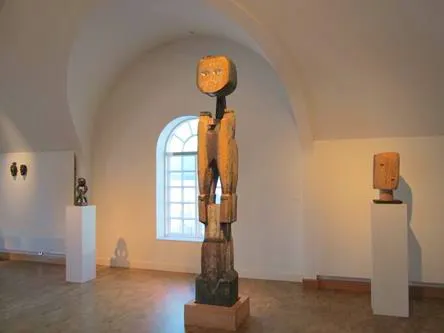
Now get back in your car and drive up the hill to Hallgrímskirkja.
- Hallgrímskirkja
Hallgrímskirkja, the church of Hallgrímur, is a Lutheran parish church in Reykjavík. The church with its unique design stands 244ft (74.5m) tall and is the largest church in Iceland and one of the tallest structures in Iceland. It has an observation deck from which you have a fantastic view of Reykjavik, the bay and snow-covered mountains in the distance.
The church is named after the Icelandic poet and clergyman Hallgrímur Pétursson (1614–1674).
Hallgrimskirkja is one of the city's best-known landmarks, but Domkirkjan (City Cathedral) that you visited earlier, is the seat of the Bishop of Iceland and the central church of the Evangelical Lutheran Church of Iceland.
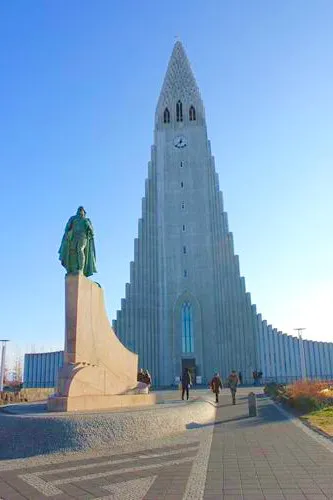
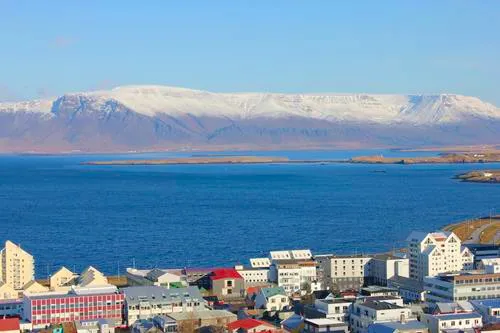
Here are some facts of Hallgrimskirkja:
state architect Guðjón Samúelsson's designed the church which was commissioned in 1937
the design it said to resemble the trap rocks, mountains, and glaciers of Iceland
the design is similar in style to the expressionist architecture of Grundtvig's Church of Copenhagen
it took 41 years to build the church (1945-1986)
the tower was completed long before the rest of the church was completed
the crypt beneath the choir was consecrated in 1948
the steeple and wings were completed in 1974
the nave was consecrated in 1986
the original design called for a shorter tower, but the church leaders it to be taller than Landakotskirkja, which was the cathedral of the Catholic Church on Iceland
the interior is 18,040 sqft (1,676 square meter)
the church underwent major restoration in 2008 and 2009
the large pipe organ was built in 1992 by Johannes Klais of Bonn, Germany. It has 102 ranks, 72 stops and 5275 pipes and is 49ft (15m) tall and weighs 25 metric tons
in front of the church stands a statue of explorer Leif Erikson (970–1020). It was made by Alexander Stirling Calder and was a gift from the United States in honor of the 1930 Althing Millennial Festival, commemorating the 1000th anniversary of Iceland's parliament at Þingvellir in 930
opening hours: Winter (October – April): 9am to 5pm and Summer (May – September): 9am to 9pm
Now, take your car and drive to the next stop: Perlan.
- Perlan
Perlan (The Pearl), is another prominent landmark in Reykjavík. At first sight, Perlan looks like a bunch of water tanks, and this is actually how it all started. In 1939, a single hot water tank was constructed on Öskjuhlíð hill, where Perlan stands today. The location was chosen as it is about 180ft (61m) above sea level and thus a water tower here provides enough pressure to supply all of Reykjavik with water. Over the next two decades, five more tanks were erected only to be torn down and reconstructed in the late 1980s. In 1991, those six hot water tanks were converted into the Perlan that you see today. This project was pushed by mayor Davíð Oddsson, the same mayor who laid the cornerstone for Reykjavik's city hall in 1991. Each tank can keep up to 1.1mio gallons (4mio liters) of hot water.
When you visit Perlan, make sure to see the "Wonders of Iceland" exhibition that shows the beauty of Iceland's natural scenery and a timeline that explains how Iceland was formed. Also, don't miss the observation deck for scenic views of Reykjavik.
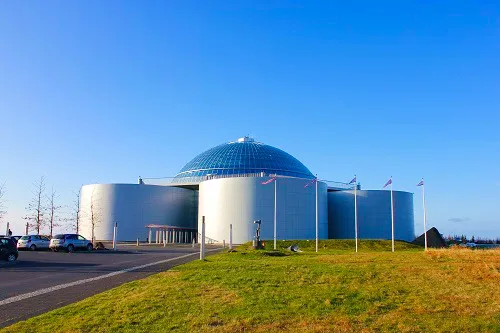
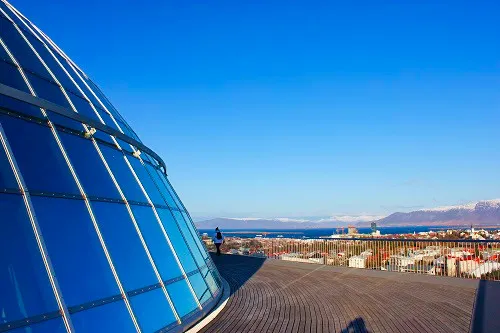
Now, take your car and drive to Nauthólsvík Beach.
- Nauthólsvík Beach
Nauthólsvík Beach is an ocean beach with an artificial hot spring. The ocean temperature is usually about 54-61F (12-16°C) during the summer and goes down to 28F (-2°C) in winter. The water temperature of the hot tub is 101F (38-39°C) year-round, the second hot tub, however, is cooler. Enjoy hopping in the hot tub if you feel like it! There are changing facilities, showers, and lockers.
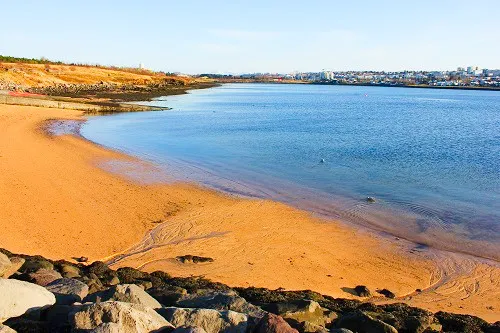
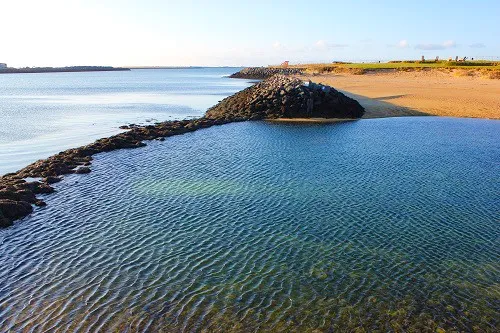
Now get back in your car and drive to Höfði House.
- Höfði House
Höfði House was built in 1909, and is considered to be one of the most beautiful and historically significant buildings in Reykjavík. It is best known as the location of the 1986 summit of US president Ronald Reagan and the Soviet Union's president Mikhail Gorbachev. This summit is often characterized as the beginning of the end of the Cold War.
The building is owned by the City of Reykjavík and is used for official receptions and meetings. It is not open to the public, but you can explore the park around the house. The sculpture in front of the house depicts pillars from the chieftain’s seat of the first Norwegian settler in Reykjavík.
Höfði House was originally used by the French consul in Iceland. Later on it was owned by Britain, but was sold after a former British Ambassador who lived here thought he saw a ghost ("The White Lady") and persuaded the British Foreign Office to sell the house.
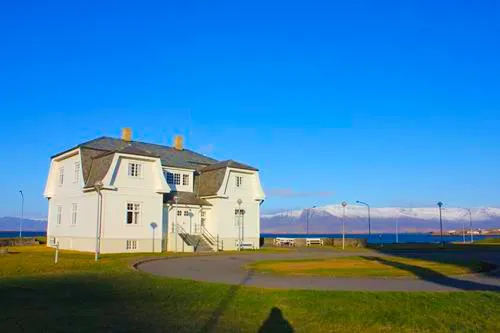
After so much sightseeing and walking, you deserve a relaxing end to this day. Get in your car and drive to the last destination for today.
- Laugardalslaug
No Iceland visit would be complete without taking a bath in at least one of the thermal baths. If you don't want to spend your nest egg on a visit to the Blue Lagoon, Laugardalslaug (pool of Laugardalur) is an excellent alternative. Laugardalslaug is a public thermal bath and swimming pool complex located in the Laugardalur district Reykjavík.
Laugardalslaug is the largest thermal bath complex in Iceland, and it gets about 800,000 visitors per year!
The complex was built from 1958–1968, expanded in 1981–1986 and 2002–2005. It now features an indoor Olympic-size swimming pool, a 50m long outdoor pool, a 400m2 playing pool, 8 hot pots of various temperatures, and a 17m2 steam bath.
The water temperatures of the large pools are around 28°C, whereas the hot pot temperatures go up to 39-44°C.
For everyone who has not been at a thermal bath in Iceland, there are certain rules that need to be obeyed. So, please read them carefully:
- Shoes off
Outside the changing rooms are shoe shelves where you have to leave your shoes. Sometimes a plastic bag is provided. Nobody will steal your shoes. If you absolutely do not want to leave your shoes on the shelf, you can store them you a locker in the changing room. But you must take them off at the shelf. - Get a locker
A locker to store your belongings (including cameras and cell phones!) is included in the admission fee. You will get the key, which is attached to an elastic band, when you pay admission. You should put the elastic band around your wrist and bring it into the pool with you. - Shower nude - without bathing suit
This is probably the most important rule, and some people claim that there is a shower police which is watching to make sure that you do it right! This is not the case in my experience, but other visitors may call you out if you violate this rule.
Showering in the nude and properly cleaning yourself is very important as the thermal pools are not or almost not chlorinated and bacteria that you bring into the pool by not obeying this rule could spread and infect many people.
If you are uncomfortable showering in an open space with other people, you can ask the staff if there is a private shower.
Once you hit the showers you have to properly wash yourself with the provided soap (some people bring their own) and without your swimsuit. Obviously, your swimsuit should be clean, too. Icelanders take swimming pool hygiene very seriously, so don't think of trying to skip the showers! - Leave your towel and shampoo in the shelves by the showers. The shelves usually right before the showers. You can also take your towel to the pool if you feel like it. Again, nobody will steal it.
- Put your swimsuit back on and go to the pool.
- Relax in the hot pools.
Which part of Iceland do you want to visit now?
Author: Rudy at Backpack and Snorkel
Bio: Owner of Backpack and Snorkel Travel Guides. We create in-depth guides to help you plan unforgettable vacations around the world.
Other popular Purple Travel Guides you may be interested in:
Like this Backpack and Snorkel Purple Travel Guide? Pin these for later:
